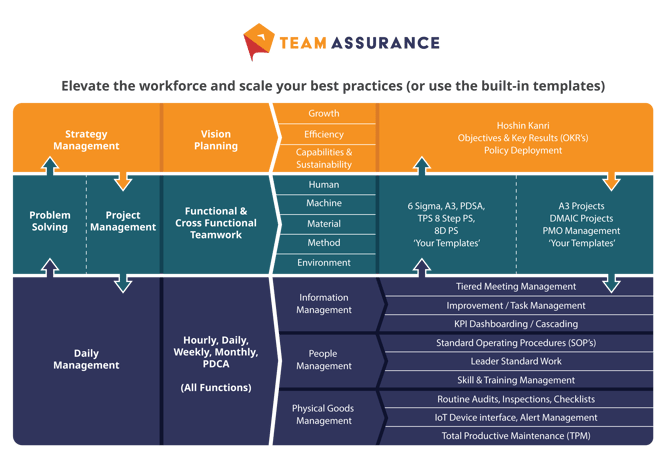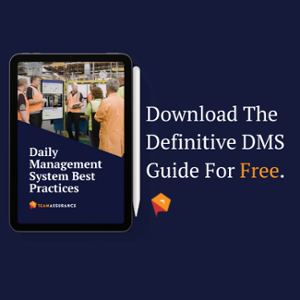Joining the Dots with Strategy Deployment

Here's how Hoshin Kanri (a strategy deployment method) is both benefitted by, and supports, flow in your continuous improvement efforts.
Continuous improvement is many things and one of the key focal points is the concept of flow. Flow is about seeking the smoothest and most direct path for many process elements. We must consider all the components, parts and raw material inputs that come together to service our customer’s needs. When talking about flow in the context of process improvement we tend to primarily focus on the flow of material, information, and communication.
Our continuous improvement activity revolves around removing the waste that inhibits or interrupts the flow of these value streams. This is all necessary short to medium term activity. However, if there is no longer term vision, or clear future state, then we can encounter some problems.
Strategy deployment: a lean perspective
Another perspective on flow is a focus on the direction of the organisation. Where are we going? Why? How are we going to get there? Organisations on the whole tend not to do this part very well. There may be a vague concept of the overarching strategy, it may simply be a management by objectives, numbers driven game. It can even be a wish list of items that are never actualised.
The question is - how do we ensure that our daily activity, energy and resources are working toward goals beyond the day, the week, the month, the year?
In the Lean world we talk about the concept of Hoshin Kanri:
- Hoshin: direction, principle, policy, course
- Kanri : management, control, maintenance
It is essentially a method for strategy deployment of mid to long term objectives. It is a structure to manage these objectives within a framework of PDCA (Plan Do Check Act). Think of this method as a rudder steering a boat or the true north of a compass – it keeps us on course steering us toward our overall objectives and helps us to navigate and organise the minutia of the day to day without losing sight of the overall destination.
Hoshin planning is not only about setting and managing longer term objectives it is also focussed on the alignment of people, process and activity vertically and horizontally throughout the organisation. Alignment is the key to successful and sustainable long term activity and we need everyone in the organisation to be clear and on board with the plan and the direction.
The foundation of great strategy deployment
Without this we inhabit a world where we are stuck in the weeds of the day to day. We end up with a myopic view of improvement or have misaligned initiatives. This takes the organisation in contrary directions to what we actually need.
A Hoshin plan requires the foundational elements of:
- A Purpose or Why? statement: A clear understanding of who we are as an organisation and what we are here to do.
- Clearly defined philosophy or values: How do we need to think and behave to achieve our purpose?
- A long term vision for the organisation anywhere from 3 to 10 years
- An understanding of the current needs of the organisation: What are the obstacles, priorities and opportunities over the next 12 months that will help move us toward the long term vision?
- Buy in, engagement and input from everyone in the organisation: A hoshin plan must involve consultation throughout the organisation to develop the plan prior to deployment.
Ultimately Hoshin planning is bigger picture PDCA activity. The essence of Hoshin is that it is has laser focussed clarity. It is simple to interpret and execute and it is flexible to the organisation’s needs (or the situation) like all Lean tools are intended to be.
The scope of a Hoshin plan
A Hoshin plan will typically have a scope of 12 months. It should be clear and concisely articulated. Coming back to the concept of flow, it is critical that we ensure that a Hoshin is not just a top down approach. Remember our discussion on Nemawashi? It must be developed through consultation with all stakeholders through a “catchball” process. A draft plan should be communicated and discussed vertically and horizontally throughout the organisation. Giving at least 3 months prior to implementation is good buffer. The analogy being to throw the ball to everyone so they can see, feel and touch it and provide feedback on the return.
The management of a Hoshin plan like daily management should be clear, simple and visual. It should be broken down to component parts and woven into the DNA of daily activity. The key focus points and activity on an hour to hour, day to day basis should directly link to the annual objectives.
Routine continuous improvement activities is crucial
I would typically recommend that the key Hoshin elements are broken down into quarterly cycles and further broken down into fortnightly review/touchpoints. In larger organisations this may cascade through the layers of management and function - right down to team and individual objectives.
Following PDCA methodology, this approach again facilitates a clear focus on what is important now. It also provides a mechanism for continuous feedback, adjustment and reflection on the strategy. It is a case of understanding what the organisation “should” do, not what it “can” or “could” do.
View strategy deployment as part of the greater C.I. Framework
For effective strategy deployment we must ensure alignment of all the people, processes and systems involved. Lean tools like standardised problem solving techniques, Standard Operating Procedures (SOPs), and a Tiered Daily Management process that supports the entire PDCA loop are key to achieving strategy success.
The illustration below demonstrates how we designed the interconnected TeamAssurance platform to avoid locally optimised, disconnected ‘Point Solutions’ (digital or analog) that do not help, and may even hinder your organisation’s strategy deployment goals.

If you’re a business in need (or a consultant with clients in need) and you'd like to explore the opportunities that digital-aids to Lean tools provide contact us for a demonstration of the TeamAssurance platform today.


